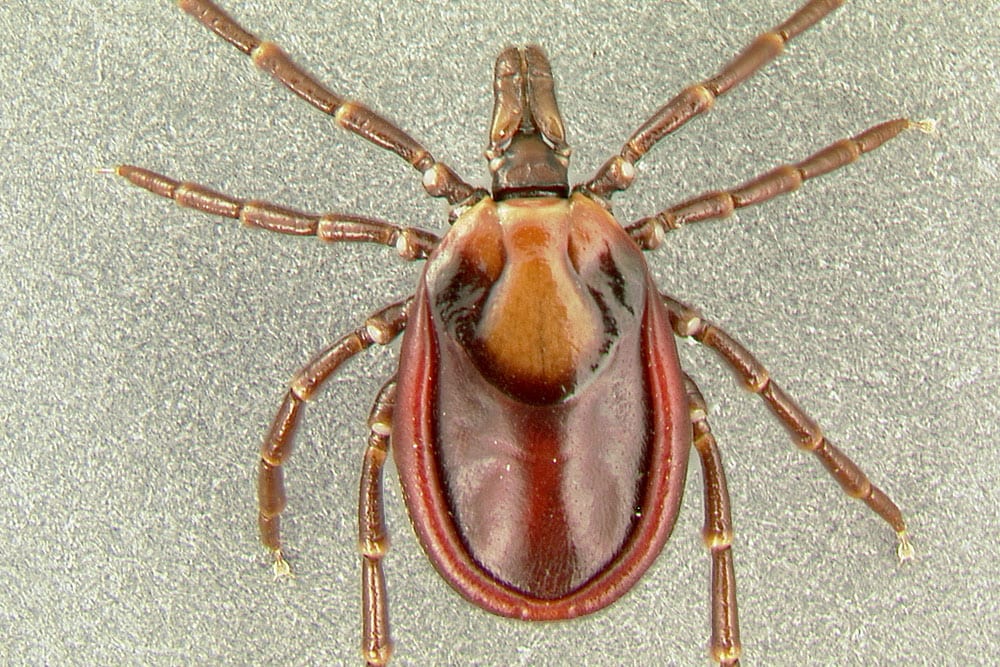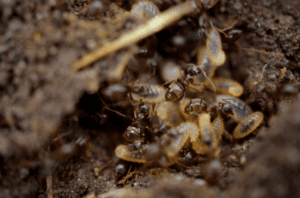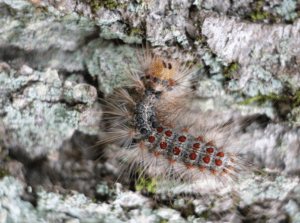
Ticks are among the worst pests in terms of disease transmission. Keep your family and pets safe this tick season by arming yourself with everything you need to know about these blood-sucking pests.
What Are Ticks and What Do They Look Like?
Though often thought to be insects, ticks are in fact arachnids. This makes them relatives of spiders, scorpions, and mites. Ticks vary in appearance depending on species, but all adult ticks have eight legs and a body whose shape is reminiscent of an apple seed. Nymphs also have eight legs, however larvae only have six. Male and female ticks both feed on the blood of humans and animals. Unfed, a tick’s body appears flat. A fed tick appears more plump. Male ticks do not grow as much as females after feeding; female ticks feed until they are engorged and become much larger than fed males. The three most common species of ticks in New Jersey are blacklegged ticks (a.k.a. deer ticks), American dog ticks, and Lone Star ticks.
Blacklegged ticks, as their name suggests, have all-black legs. Adult males are smaller than their female counterparts, only growing to around 3 mm long. Their scutum, or the shield that covers their body, is black or dark brown in color. The male’s scutum covers most of its body, while the female’s covers only a small part. The female’s much smaller shield is also dark in color, while the rest of her body is brown or reddish-orange. Females reach between 3 and 5 mm in length, but they can grow to 10 mm after a meal. Deer ticks become more reddish-brown in color as they feed.
American dog ticks, also referred to as wood ticks, are reddish brown with gray or whitish markings on their shields. Males have much larger shields than females and their bodies grow to be around 3.6 mm in size. Females are roughly 5 mm while unfed and can reach ½ inch in size after feeding. As they feed, their bodies develop a gray color.
Lone Star ticks are easily recognizable by their unique color patterns. Females have a single white dot in the middle of their reddish-brown or tan bodies, which is what earned the species its name. They are roughly 3 mm in size before a meal, and can reach ½ inch after a meal. Males have streaks of white around the edges of their bodies and are slightly smaller than unfed females.
When Is Tick Season in New Jersey?
Ticks are most active in New Jersey from April to September with peak activity occurring during May, June, and July. That being said, ticks emerge any time temperatures are above freezing which means that tick exposure is possible year-round.
Where Do Ticks Live?
Ticks generally live in wooded areas, tall grass or brush. They prefer warm, humid climates, but they are able to adapt to a wide variety of environments. As long as a host is near and temperatures are above freezing, ticks can survive. Ticks do not live on their hosts, but they like to live near them. While feeding upon their hosts, they tend to hide near the head, neck, underarms, or groin.
What Attracts Ticks?
Ticks are attracted to humid, shady areas with plenty of hiding spots like grassy fields, overgrown lawns, woods, brush piles, naturalized areas, and more. They are also attracted to high host populations. Ticks can sense carbon dioxide and sweat output, so they know exactly where to find potential hosts. Rodent burrows, bird nests, animal dens, dog or pet houses, livestock pens, hiking trails, and campgrounds are very attractive to hungry ticks.
What Hosts Do Ticks Prefer?
Tick species are split into three groups: one-host, two-host, and three-host. All species develop through the stages of egg, larva, nymph, and adult. Eggs hatch into larvae, also called seed ticks. Seed ticks need to feed in order to molt into nymphs. Nymphs again need to feed in order to molt. Some species molt through several nymphal stages, while others only undergo one nymph stage before becoming an adult. Adults feed one final time so they can reproduce. One-host ticks feed on the same host during each stage of life and only leave their host when they are ready to reproduce. Multi-host species leave their hosts after each meal to molt before finding a new host or returning to the previous host for their next meal. Most of the commonly-encountered species are three-host ticks. The following are the preferred hosts of New Jersey’s most common tick species:
Blacklegged Tick
- Larvae- small hosts like rodents, birds, rabbits, raccoons, and skunks
- Nymphs- any sized host from small rodents to humans
- Adults- Larger hosts like deer, cattle, horses, and humans
American Dog Tick
- Larvae- small hosts like rodents, birds, rabbits, raccoons, and skunks
- Nymphs- small to medium hosts like rodents and raccoons
- Adults- medium or large hosts like raccoons, dogs, humans, deer, cattle, and horses
Lone Star Tick
- Larvae- small hosts like rodents, birds, rabbits, raccoons, and skunks
- Nymphs- small hosts like rodents, birds, rabbits, raccoons, and skunks
- Adults- medium or large hosts like raccoons, dogs, humans, deer, cattle, and horses
How Long Do Ticks Live?
On average, ticks live between 1 and 3 years. A tick’s lifespan varies depending on a number of factors including species and host availability. One-host ticks have shorter lifespans than two- and three-host ticks.
Can Ticks Jump or Fly?
Ticks can neither jump nor fly. As such, they have to use alternative methods to reach a meal. Sometimes they can simply crawl onto a host, but often they have to perch in precarious places and wait for a host to pass by. They usually perch on plant leaves, tree branches, and tall blades of grass. If the approaching host is tall enough, the tick simply grabs onto the host as it passes. If the host is smaller, the tick will freefall onto it.
Depending on its age and species, a tick may feed for anywhere from a few hours to fourteen days. Most ticks feed slowly for at least a few days. Some species cannot live without a host for more than a month or two, while others can last for several years without feeding.
How Do Ticks Spread Diseases?
Ticks spread diseases when they feed. If a host is carrying a disease, its blood will infect the tick with the same disease. When the tick feeds on its next host, the disease may enter the next host’s bloodstream through the tick’s saliva. Typically, disease transmission requires more than 24 hours. Disease transmission is possible within a shorter amount of time, though it is far less likely.
What Does a Tick Bite Look Like?
After a tick detaches from a host, the spot they bit typically looks like a small red dot or bump that is no larger than the size of a dime. The dot or bump may have a black dot at the center. If the tick bite caused the transmission of a tick-borne illness, a secondary rash may also appear. Rashes caused by tick bites usually look like a bullseye around the bite, red splotches, red pinpoint dots, or a skin ulcer. Other symptoms of tick-borne illnesses include body and joint aches, fever and chills, headache, fatigue, and swollen lymph nodes.
How To Remove an Attached Tick
To remove an attached tick, use tweezers to grab it as close to the host’s skin as possible. Gently pull it straight out without twisting. Ideally, the tick’s head will be pulled out with its body, but it may detach and remain embedded in the skin. This may cause some mild skin irritation but the head will eventually fall out on its own. After removing the tick, either flush it down the toilet, place it in an airtight bag or container, or place it in rubbing alcohol. Promptly clean the bite with rubbing alcohol or soap and warm water.
What Kinds of Ticks Carry Lyme Disease?
Lyme disease is primarily carried and transmitted by the blacklegged tick. In Pacific coast states, it is primarily carried by the western blacklegged tick.
What Other Diseases Do Ticks Carry?
Other diseases transmitted by ticks in the Northeast United States include anaplasmosis, babesiosis, Borrelia miyamotoi infection, ehrlichiosis, powassan disease, Rocky Mountain spotted fever, STARI, and tularemia.
Lone Star ticks have also been known to cause a condition called Alpha-gal syndrome which can lead to a red meat allergy.
American dog ticks produce a toxic secretion that can cause temporary paralysis in dogs and children. The paralysis occurs when the tick attaches to the base of the skull or spinal column, and typically wears off within 24 hours of the tick’s removal.
How To Prevent Ticks on Your Property
- Eliminate outdoor clutter by keeping vegetation trimmed, mowing your lawn regularly, and promptly removing debris piles. In addition, keep firewood piles, patio furniture, and play structures in sunny, dry areas.
- Create a 3-foot barrier between your yard and any wooded or grassy areas using gravel or wood chips. Create a similar border around patios and play areas.
- Landscape with tick-repelling plants like rosemary, lavender, mint, American beautyberry, geranium, and marigold.
- Prevent bites by wearing light-colored long pants, long sleeves, and tall socks when venturing into wooded, grassy, or brush-filled areas. Apply insect repellent that contains either permethrin or DEET. Treat clothing as well as camping or hiking gear with a fabric-only tick repellent that contains at least 0.5% permethrin. After returning home or to your campsite, check thoroughly for ticks and immediately remove any that you find.
If you’re worried about ticks in your yard, give Twin-Boro a call. We’ll send one of our experts to perform a free inspection and we’ll work with you to build the ideal tick control plan for your property. With Twin-Boro, you can enjoy your backyard without the threat of ticks.






